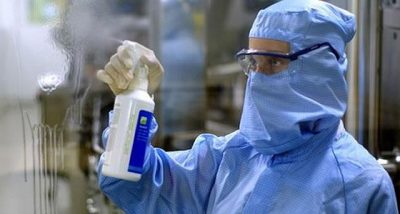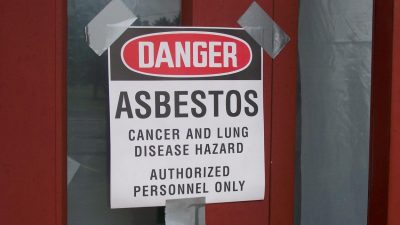Decontamination is a term used to describe a process or treatment that renders a medical device, instrument, or environmental surface safe to handle. Sterilization, disinfection, and antisepsis are all forms of decontamination.
All infectious materials and all contaminated equipment or apparatus should be decontaminated before being washed, stored, or discarded. Autoclaving is the preferred method. Each individual working with biohazardous material should be responsible for its proper handling.
Levels of decontamination
The effectiveness of decontamination ranges from high-level sterilization to simple cleaning with soap and water. Levels of decontamination include:
Sterilization uses a physical or chemical procedure to destroy all microbial life, including highly resistant bacterial endospores.
Disinfection uses a liquid chemical to eliminate virtually all pathogenic microorganisms, with the exception of bacterial spores, on work surfaces and equipment. Effectiveness is influenced by the kinds and numbers of organisms, the amount of organic matter, the object to be disinfected, and chemical exposure time, temperature, and concentration.
Antisepsis is the application of a liquid antimicrobial chemical to the skin or living tissue to inhibit or destroy microorganisms. It includes swabbing an injection site on a person or animal and handwashing with germicidal solutions. Manufacturer recommendations for appropriate use of germicides should always be followed.
Cleaning uses water, detergent, and some mechanical action such as scrubbing with a gloved hand or brush. Cleaning is often a required step before sterilization or disinfection of inanimate objects because it removes all material such as soil or organic material and reduces the number of microorganisms on an object.
Methods
There are 4 main categories of physical and chemical means of decontamination: (1) heat; (2) liquid disinfection; (3) vapors and gases; and (4) radiation. Each category is discussed below.
1. Heat sterilization (wet or dry)
Wet heat
Wet heat is the most dependable method of sterilization.
Autoclaving, sometimes called steam sterilization, is the most convenient method of rapidly achieving the destruction of all forms of microbial life. Autoclaves use saturated steam under pressure of approximately 15 pounds per square inch to achieve a chamber temperature of at least 250°F (121°C) for a prescribed time—usually 30–60 minutes. Typical uses: Autoclaving is a dependable method of sterilizing laboratory equipment and decontaminating biohazard wastes.
Dry heat
Dry heat is less efficient than wet heat and requires longer times and/or higher temperatures to achieve sterilization. It is suitable for the destruction of viable organisms on impermeable non-organic surfaces such as glass, but it is not reliable in the presence of shallow layers of organic or inorganic materials which may act as insulation.
Typical uses: Sterilization of glassware by dry heat can usually be accomplished at 160°–170°C for periods of 2 to 4 hours.
2. Liquid disinfection
Liquid disinfectants can be generally classified as halogens, acids, alkalis, heavy metal salts, quaternary ammonium compounds, phenolic compounds, aldehydes, ketones, alcohols, and amines.
Liquid disinfectant effectiveness varies with the organism, concentration, contact time, and other conditions of use. Select only liquid disinfectants that are confirmed to be effective against the organism(s) present. No liquid disinfectant is equally useful or effective under all conditions and for all viable agents.
Typical uses: Liquid disinfectants are used for surface decontamination and, when used in sufficient concentration, as a decontaminate for liquid wastes prior to final disposal in the sanitary sewer.
Consult Summary of Disinfectants for recommended disinfectants, their uses, and requirements. NOTE: The chart below provides guidelines for surface decontamination For chemical disinfection of liquid biohazardous waste, the only university-wide approved disinfectant for UCSD is bleach (1 part bleach to 9 parts liquid waste, 30 min. contact time, followed by sewering).
If your laboratory wishes to inquire about the use of alternative disinfectants to inactivate liquid biohazardous waste, please send an email with the following information. You will receive a response within five (5) working days regarding approval.
3. Vapors and gases
Vapors and gases, when used in closed systems and under controlled conditions of temperature and humidity, provide excellent disinfection. Agents in this category include the aerosol, vapor, or gas phase of chlorine dioxide, glutaraldehyde, paraformaldehyde, ethylene oxide, peracetic acid, and hydrogen peroxide.
Typical uses: Vapors and gases are primarily used to decontaminate biosafety cabinets, animal rooms, and their associated systems, bulky or stationary equipment not suited to liquid disinfectants, instruments or optics that might be damaged by other decontamination methods, and rooms, buildings, and associated air-handling systems.
4. Radiation (ionizing or non-ionizing)
Ionizing
Ionizing radiation will destroy microorganisms but is not a practical tool for laboratory use.
Non-ionizing
The UV-C band of ultraviolet (UV) radiation contains wavelengths (250-270 nm, 265 is optimum) that effectively destroy most microorganisms in air and water and on surfaces. Organisms must be directly exposed to the UV light; dirt, dust, and shadows can shield organisms, limiting UV lamp effectiveness.
Typical uses: Ultraviolet radiation is typically used to reduce levels of airborne microorganisms and maintain good air hygiene in airlocks, animal holding areas, ventilated cabinets, and laboratory rooms. UV is also used in biological safety cabinets (BSC) and in some laboratory rooms to reduce surface contamination.
EH&S Biosafety strongly discourages UV lamps in BSCs. See Biosafety Cabinets: Usage Guidelines.
Precautions: UV can cause burns to the eyes (photokeratitis) and skin of people exposed for even a short period of time.
Use these precautions:
Activate UV lights only when the area is unoccupied.
Use proper shielding when UV lamps are in use.
Interlock UV lamps used for space decontamination with the general room or cabinet illumination, so turning on the lights turns off the UV.
Warn new and visiting personnel about the hazardous effects of UV radiation and the appropriate precautions to take.
Maintenance
Because UV lamp intensity (its destructive power) decreases with time, proper maintenance is critical for decontamination purposes. Perform this regular maintenance:
Check lamp efficiency monthly with a UV meter or monitoring strip.
Clean UV lamps every few weeks to prevent dust and dirt from accumulating that drastically reduces UV lamp effectiveness.




